Effect of Outsourcing on Firm's Production in Industry - Literature Review
VerifiedAdded on 2023/06/12
|10
|3362
|271
AI Summary
This literature review explores the concept of outsourcing and firm's production, and provides empirical studies to explain the contribution of outsourcing to firm's production in an industry. It also discusses the positivism and negativism of outsourcing on firm's production.
Contribute Materials
Your contribution can guide someone’s learning journey. Share your
documents today.
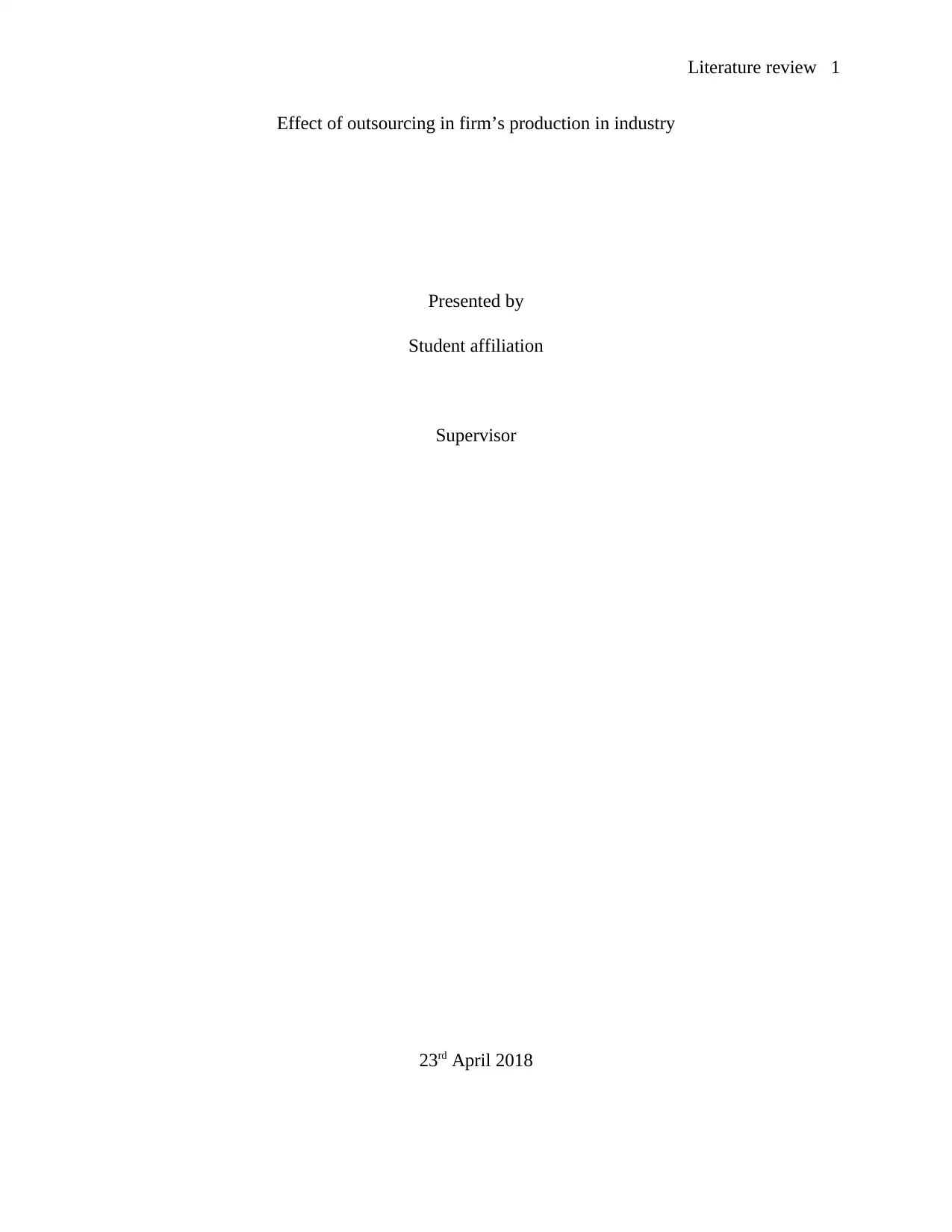
Literature review 1
Effect of outsourcing in firm’s production in industry
Presented by
Student affiliation
Supervisor
23rd April 2018
Effect of outsourcing in firm’s production in industry
Presented by
Student affiliation
Supervisor
23rd April 2018
Secure Best Marks with AI Grader
Need help grading? Try our AI Grader for instant feedback on your assignments.
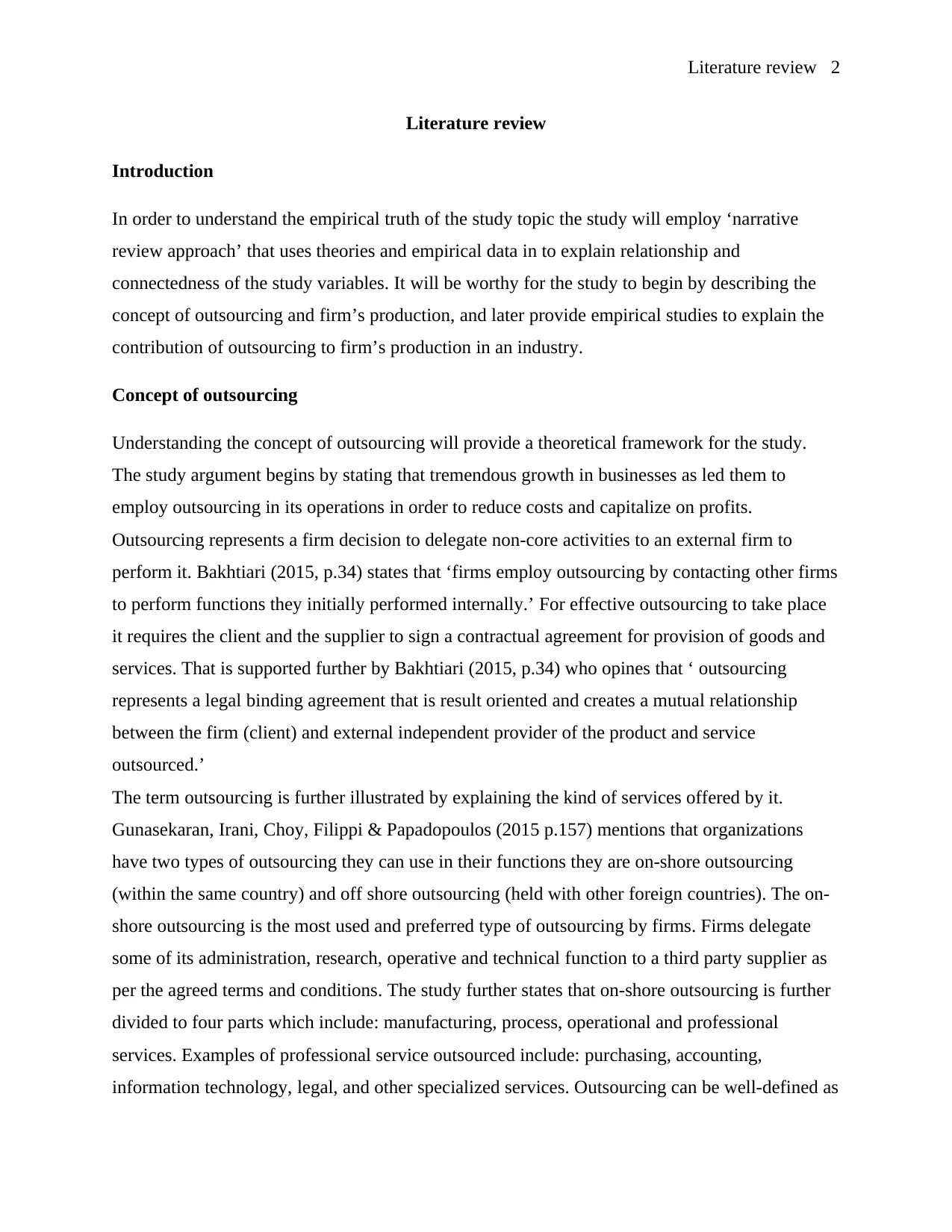
Literature review 2
Literature review
Introduction
In order to understand the empirical truth of the study topic the study will employ ‘narrative
review approach’ that uses theories and empirical data in to explain relationship and
connectedness of the study variables. It will be worthy for the study to begin by describing the
concept of outsourcing and firm’s production, and later provide empirical studies to explain the
contribution of outsourcing to firm’s production in an industry.
Concept of outsourcing
Understanding the concept of outsourcing will provide a theoretical framework for the study.
The study argument begins by stating that tremendous growth in businesses as led them to
employ outsourcing in its operations in order to reduce costs and capitalize on profits.
Outsourcing represents a firm decision to delegate non-core activities to an external firm to
perform it. Bakhtiari (2015, p.34) states that ‘firms employ outsourcing by contacting other firms
to perform functions they initially performed internally.’ For effective outsourcing to take place
it requires the client and the supplier to sign a contractual agreement for provision of goods and
services. That is supported further by Bakhtiari (2015, p.34) who opines that ‘ outsourcing
represents a legal binding agreement that is result oriented and creates a mutual relationship
between the firm (client) and external independent provider of the product and service
outsourced.’
The term outsourcing is further illustrated by explaining the kind of services offered by it.
Gunasekaran, Irani, Choy, Filippi & Papadopoulos (2015 p.157) mentions that organizations
have two types of outsourcing they can use in their functions they are on-shore outsourcing
(within the same country) and off shore outsourcing (held with other foreign countries). The on-
shore outsourcing is the most used and preferred type of outsourcing by firms. Firms delegate
some of its administration, research, operative and technical function to a third party supplier as
per the agreed terms and conditions. The study further states that on-shore outsourcing is further
divided to four parts which include: manufacturing, process, operational and professional
services. Examples of professional service outsourced include: purchasing, accounting,
information technology, legal, and other specialized services. Outsourcing can be well-defined as
Literature review
Introduction
In order to understand the empirical truth of the study topic the study will employ ‘narrative
review approach’ that uses theories and empirical data in to explain relationship and
connectedness of the study variables. It will be worthy for the study to begin by describing the
concept of outsourcing and firm’s production, and later provide empirical studies to explain the
contribution of outsourcing to firm’s production in an industry.
Concept of outsourcing
Understanding the concept of outsourcing will provide a theoretical framework for the study.
The study argument begins by stating that tremendous growth in businesses as led them to
employ outsourcing in its operations in order to reduce costs and capitalize on profits.
Outsourcing represents a firm decision to delegate non-core activities to an external firm to
perform it. Bakhtiari (2015, p.34) states that ‘firms employ outsourcing by contacting other firms
to perform functions they initially performed internally.’ For effective outsourcing to take place
it requires the client and the supplier to sign a contractual agreement for provision of goods and
services. That is supported further by Bakhtiari (2015, p.34) who opines that ‘ outsourcing
represents a legal binding agreement that is result oriented and creates a mutual relationship
between the firm (client) and external independent provider of the product and service
outsourced.’
The term outsourcing is further illustrated by explaining the kind of services offered by it.
Gunasekaran, Irani, Choy, Filippi & Papadopoulos (2015 p.157) mentions that organizations
have two types of outsourcing they can use in their functions they are on-shore outsourcing
(within the same country) and off shore outsourcing (held with other foreign countries). The on-
shore outsourcing is the most used and preferred type of outsourcing by firms. Firms delegate
some of its administration, research, operative and technical function to a third party supplier as
per the agreed terms and conditions. The study further states that on-shore outsourcing is further
divided to four parts which include: manufacturing, process, operational and professional
services. Examples of professional service outsourced include: purchasing, accounting,
information technology, legal, and other specialized services. Outsourcing can be well-defined as
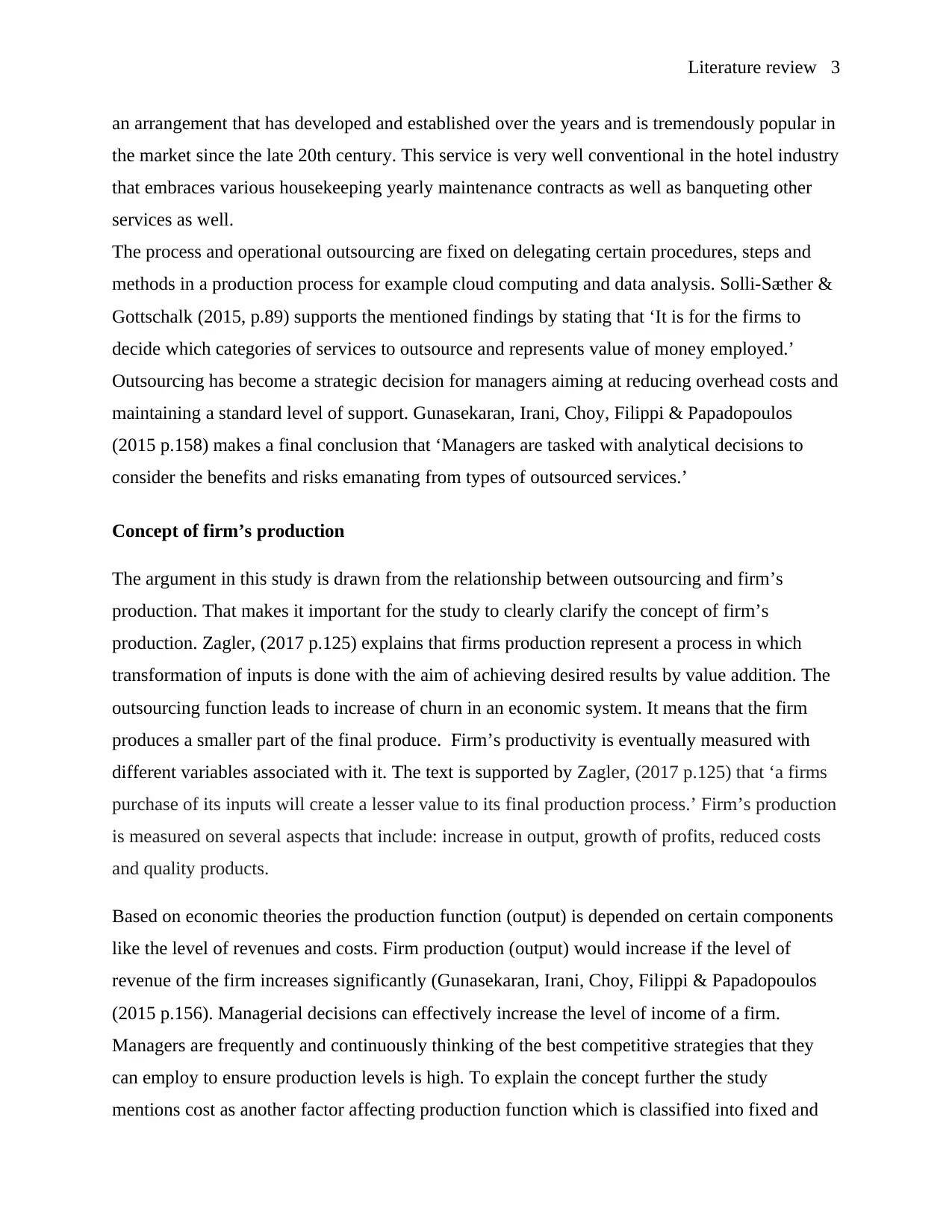
Literature review 3
an arrangement that has developed and established over the years and is tremendously popular in
the market since the late 20th century. This service is very well conventional in the hotel industry
that embraces various housekeeping yearly maintenance contracts as well as banqueting other
services as well.
The process and operational outsourcing are fixed on delegating certain procedures, steps and
methods in a production process for example cloud computing and data analysis. Solli-Sæther &
Gottschalk (2015, p.89) supports the mentioned findings by stating that ‘It is for the firms to
decide which categories of services to outsource and represents value of money employed.’
Outsourcing has become a strategic decision for managers aiming at reducing overhead costs and
maintaining a standard level of support. Gunasekaran, Irani, Choy, Filippi & Papadopoulos
(2015 p.158) makes a final conclusion that ‘Managers are tasked with analytical decisions to
consider the benefits and risks emanating from types of outsourced services.’
Concept of firm’s production
The argument in this study is drawn from the relationship between outsourcing and firm’s
production. That makes it important for the study to clearly clarify the concept of firm’s
production. Zagler, (2017 p.125) explains that firms production represent a process in which
transformation of inputs is done with the aim of achieving desired results by value addition. The
outsourcing function leads to increase of churn in an economic system. It means that the firm
produces a smaller part of the final produce. Firm’s productivity is eventually measured with
different variables associated with it. The text is supported by Zagler, (2017 p.125) that ‘a firms
purchase of its inputs will create a lesser value to its final production process.’ Firm’s production
is measured on several aspects that include: increase in output, growth of profits, reduced costs
and quality products.
Based on economic theories the production function (output) is depended on certain components
like the level of revenues and costs. Firm production (output) would increase if the level of
revenue of the firm increases significantly (Gunasekaran, Irani, Choy, Filippi & Papadopoulos
(2015 p.156). Managerial decisions can effectively increase the level of income of a firm.
Managers are frequently and continuously thinking of the best competitive strategies that they
can employ to ensure production levels is high. To explain the concept further the study
mentions cost as another factor affecting production function which is classified into fixed and
an arrangement that has developed and established over the years and is tremendously popular in
the market since the late 20th century. This service is very well conventional in the hotel industry
that embraces various housekeeping yearly maintenance contracts as well as banqueting other
services as well.
The process and operational outsourcing are fixed on delegating certain procedures, steps and
methods in a production process for example cloud computing and data analysis. Solli-Sæther &
Gottschalk (2015, p.89) supports the mentioned findings by stating that ‘It is for the firms to
decide which categories of services to outsource and represents value of money employed.’
Outsourcing has become a strategic decision for managers aiming at reducing overhead costs and
maintaining a standard level of support. Gunasekaran, Irani, Choy, Filippi & Papadopoulos
(2015 p.158) makes a final conclusion that ‘Managers are tasked with analytical decisions to
consider the benefits and risks emanating from types of outsourced services.’
Concept of firm’s production
The argument in this study is drawn from the relationship between outsourcing and firm’s
production. That makes it important for the study to clearly clarify the concept of firm’s
production. Zagler, (2017 p.125) explains that firms production represent a process in which
transformation of inputs is done with the aim of achieving desired results by value addition. The
outsourcing function leads to increase of churn in an economic system. It means that the firm
produces a smaller part of the final produce. Firm’s productivity is eventually measured with
different variables associated with it. The text is supported by Zagler, (2017 p.125) that ‘a firms
purchase of its inputs will create a lesser value to its final production process.’ Firm’s production
is measured on several aspects that include: increase in output, growth of profits, reduced costs
and quality products.
Based on economic theories the production function (output) is depended on certain components
like the level of revenues and costs. Firm production (output) would increase if the level of
revenue of the firm increases significantly (Gunasekaran, Irani, Choy, Filippi & Papadopoulos
(2015 p.156). Managerial decisions can effectively increase the level of income of a firm.
Managers are frequently and continuously thinking of the best competitive strategies that they
can employ to ensure production levels is high. To explain the concept further the study
mentions cost as another factor affecting production function which is classified into fixed and
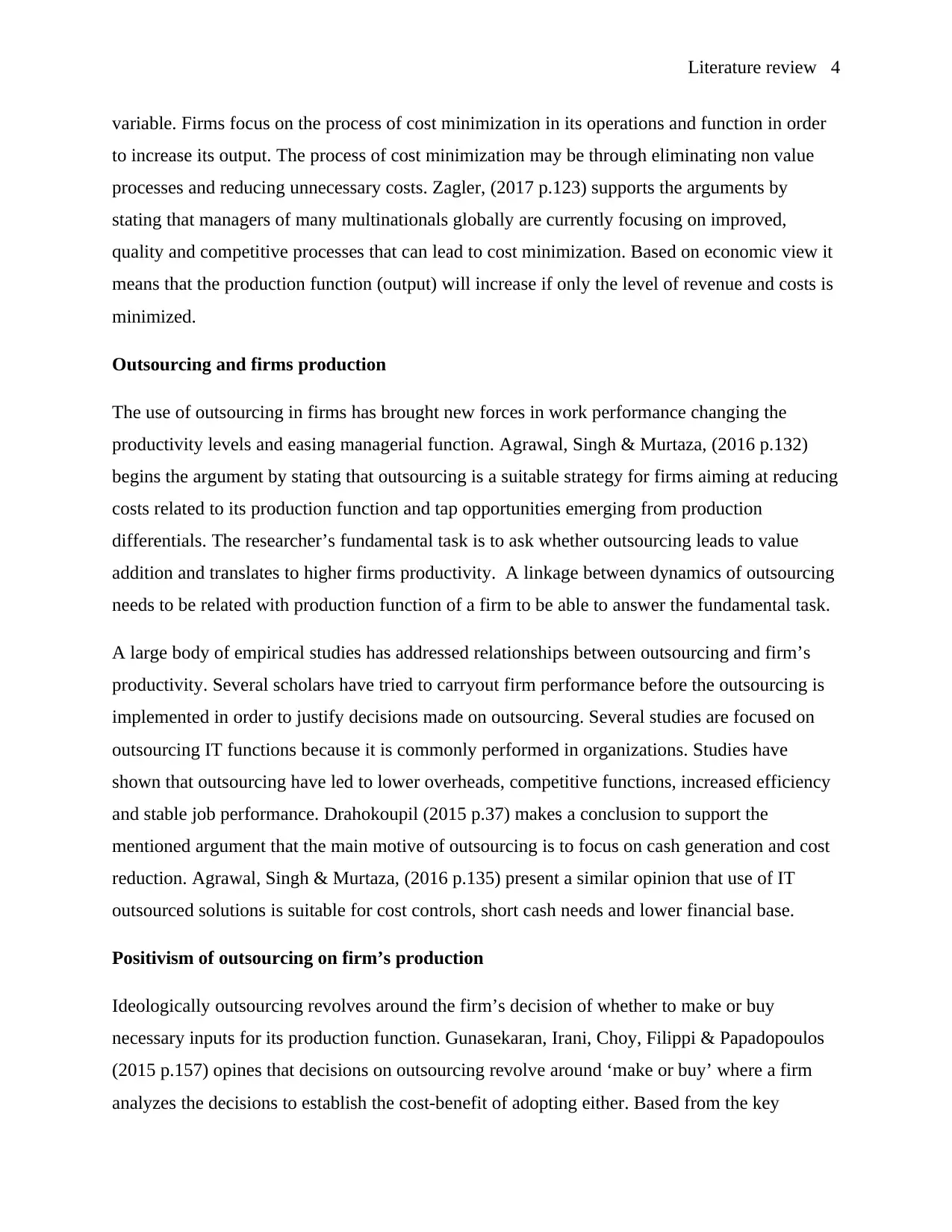
Literature review 4
variable. Firms focus on the process of cost minimization in its operations and function in order
to increase its output. The process of cost minimization may be through eliminating non value
processes and reducing unnecessary costs. Zagler, (2017 p.123) supports the arguments by
stating that managers of many multinationals globally are currently focusing on improved,
quality and competitive processes that can lead to cost minimization. Based on economic view it
means that the production function (output) will increase if only the level of revenue and costs is
minimized.
Outsourcing and firms production
The use of outsourcing in firms has brought new forces in work performance changing the
productivity levels and easing managerial function. Agrawal, Singh & Murtaza, (2016 p.132)
begins the argument by stating that outsourcing is a suitable strategy for firms aiming at reducing
costs related to its production function and tap opportunities emerging from production
differentials. The researcher’s fundamental task is to ask whether outsourcing leads to value
addition and translates to higher firms productivity. A linkage between dynamics of outsourcing
needs to be related with production function of a firm to be able to answer the fundamental task.
A large body of empirical studies has addressed relationships between outsourcing and firm’s
productivity. Several scholars have tried to carryout firm performance before the outsourcing is
implemented in order to justify decisions made on outsourcing. Several studies are focused on
outsourcing IT functions because it is commonly performed in organizations. Studies have
shown that outsourcing have led to lower overheads, competitive functions, increased efficiency
and stable job performance. Drahokoupil (2015 p.37) makes a conclusion to support the
mentioned argument that the main motive of outsourcing is to focus on cash generation and cost
reduction. Agrawal, Singh & Murtaza, (2016 p.135) present a similar opinion that use of IT
outsourced solutions is suitable for cost controls, short cash needs and lower financial base.
Positivism of outsourcing on firm’s production
Ideologically outsourcing revolves around the firm’s decision of whether to make or buy
necessary inputs for its production function. Gunasekaran, Irani, Choy, Filippi & Papadopoulos
(2015 p.157) opines that decisions on outsourcing revolve around ‘make or buy’ where a firm
analyzes the decisions to establish the cost-benefit of adopting either. Based from the key
variable. Firms focus on the process of cost minimization in its operations and function in order
to increase its output. The process of cost minimization may be through eliminating non value
processes and reducing unnecessary costs. Zagler, (2017 p.123) supports the arguments by
stating that managers of many multinationals globally are currently focusing on improved,
quality and competitive processes that can lead to cost minimization. Based on economic view it
means that the production function (output) will increase if only the level of revenue and costs is
minimized.
Outsourcing and firms production
The use of outsourcing in firms has brought new forces in work performance changing the
productivity levels and easing managerial function. Agrawal, Singh & Murtaza, (2016 p.132)
begins the argument by stating that outsourcing is a suitable strategy for firms aiming at reducing
costs related to its production function and tap opportunities emerging from production
differentials. The researcher’s fundamental task is to ask whether outsourcing leads to value
addition and translates to higher firms productivity. A linkage between dynamics of outsourcing
needs to be related with production function of a firm to be able to answer the fundamental task.
A large body of empirical studies has addressed relationships between outsourcing and firm’s
productivity. Several scholars have tried to carryout firm performance before the outsourcing is
implemented in order to justify decisions made on outsourcing. Several studies are focused on
outsourcing IT functions because it is commonly performed in organizations. Studies have
shown that outsourcing have led to lower overheads, competitive functions, increased efficiency
and stable job performance. Drahokoupil (2015 p.37) makes a conclusion to support the
mentioned argument that the main motive of outsourcing is to focus on cash generation and cost
reduction. Agrawal, Singh & Murtaza, (2016 p.135) present a similar opinion that use of IT
outsourced solutions is suitable for cost controls, short cash needs and lower financial base.
Positivism of outsourcing on firm’s production
Ideologically outsourcing revolves around the firm’s decision of whether to make or buy
necessary inputs for its production function. Gunasekaran, Irani, Choy, Filippi & Papadopoulos
(2015 p.157) opines that decisions on outsourcing revolve around ‘make or buy’ where a firm
analyzes the decisions to establish the cost-benefit of adopting either. Based from the key
Secure Best Marks with AI Grader
Need help grading? Try our AI Grader for instant feedback on your assignments.
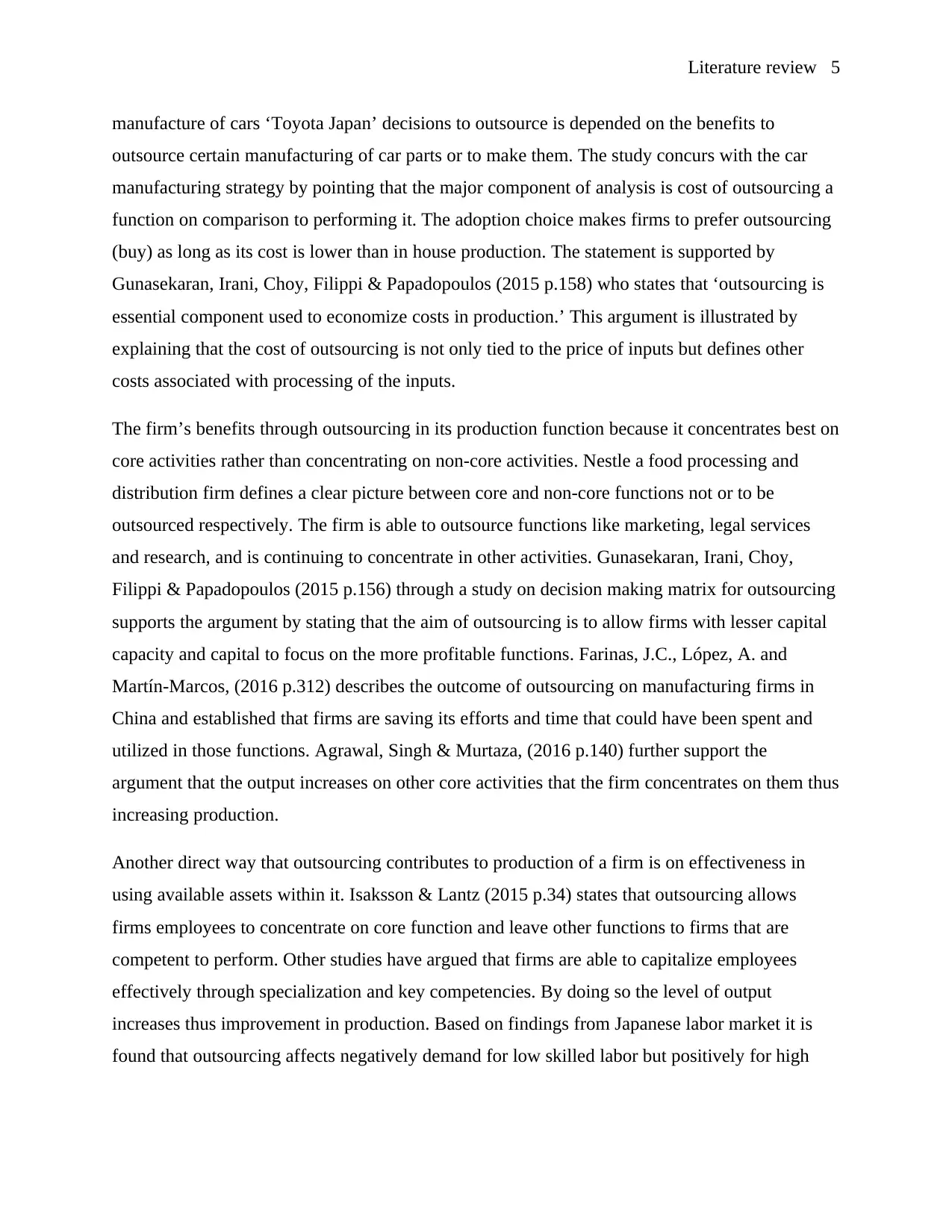
Literature review 5
manufacture of cars ‘Toyota Japan’ decisions to outsource is depended on the benefits to
outsource certain manufacturing of car parts or to make them. The study concurs with the car
manufacturing strategy by pointing that the major component of analysis is cost of outsourcing a
function on comparison to performing it. The adoption choice makes firms to prefer outsourcing
(buy) as long as its cost is lower than in house production. The statement is supported by
Gunasekaran, Irani, Choy, Filippi & Papadopoulos (2015 p.158) who states that ‘outsourcing is
essential component used to economize costs in production.’ This argument is illustrated by
explaining that the cost of outsourcing is not only tied to the price of inputs but defines other
costs associated with processing of the inputs.
The firm’s benefits through outsourcing in its production function because it concentrates best on
core activities rather than concentrating on non-core activities. Nestle a food processing and
distribution firm defines a clear picture between core and non-core functions not or to be
outsourced respectively. The firm is able to outsource functions like marketing, legal services
and research, and is continuing to concentrate in other activities. Gunasekaran, Irani, Choy,
Filippi & Papadopoulos (2015 p.156) through a study on decision making matrix for outsourcing
supports the argument by stating that the aim of outsourcing is to allow firms with lesser capital
capacity and capital to focus on the more profitable functions. Farinas, J.C., López, A. and
Martín-Marcos, (2016 p.312) describes the outcome of outsourcing on manufacturing firms in
China and established that firms are saving its efforts and time that could have been spent and
utilized in those functions. Agrawal, Singh & Murtaza, (2016 p.140) further support the
argument that the output increases on other core activities that the firm concentrates on them thus
increasing production.
Another direct way that outsourcing contributes to production of a firm is on effectiveness in
using available assets within it. Isaksson & Lantz (2015 p.34) states that outsourcing allows
firms employees to concentrate on core function and leave other functions to firms that are
competent to perform. Other studies have argued that firms are able to capitalize employees
effectively through specialization and key competencies. By doing so the level of output
increases thus improvement in production. Based on findings from Japanese labor market it is
found that outsourcing affects negatively demand for low skilled labor but positively for high
manufacture of cars ‘Toyota Japan’ decisions to outsource is depended on the benefits to
outsource certain manufacturing of car parts or to make them. The study concurs with the car
manufacturing strategy by pointing that the major component of analysis is cost of outsourcing a
function on comparison to performing it. The adoption choice makes firms to prefer outsourcing
(buy) as long as its cost is lower than in house production. The statement is supported by
Gunasekaran, Irani, Choy, Filippi & Papadopoulos (2015 p.158) who states that ‘outsourcing is
essential component used to economize costs in production.’ This argument is illustrated by
explaining that the cost of outsourcing is not only tied to the price of inputs but defines other
costs associated with processing of the inputs.
The firm’s benefits through outsourcing in its production function because it concentrates best on
core activities rather than concentrating on non-core activities. Nestle a food processing and
distribution firm defines a clear picture between core and non-core functions not or to be
outsourced respectively. The firm is able to outsource functions like marketing, legal services
and research, and is continuing to concentrate in other activities. Gunasekaran, Irani, Choy,
Filippi & Papadopoulos (2015 p.156) through a study on decision making matrix for outsourcing
supports the argument by stating that the aim of outsourcing is to allow firms with lesser capital
capacity and capital to focus on the more profitable functions. Farinas, J.C., López, A. and
Martín-Marcos, (2016 p.312) describes the outcome of outsourcing on manufacturing firms in
China and established that firms are saving its efforts and time that could have been spent and
utilized in those functions. Agrawal, Singh & Murtaza, (2016 p.140) further support the
argument that the output increases on other core activities that the firm concentrates on them thus
increasing production.
Another direct way that outsourcing contributes to production of a firm is on effectiveness in
using available assets within it. Isaksson & Lantz (2015 p.34) states that outsourcing allows
firms employees to concentrate on core function and leave other functions to firms that are
competent to perform. Other studies have argued that firms are able to capitalize employees
effectively through specialization and key competencies. By doing so the level of output
increases thus improvement in production. Based on findings from Japanese labor market it is
found that outsourcing affects negatively demand for low skilled labor but positively for high
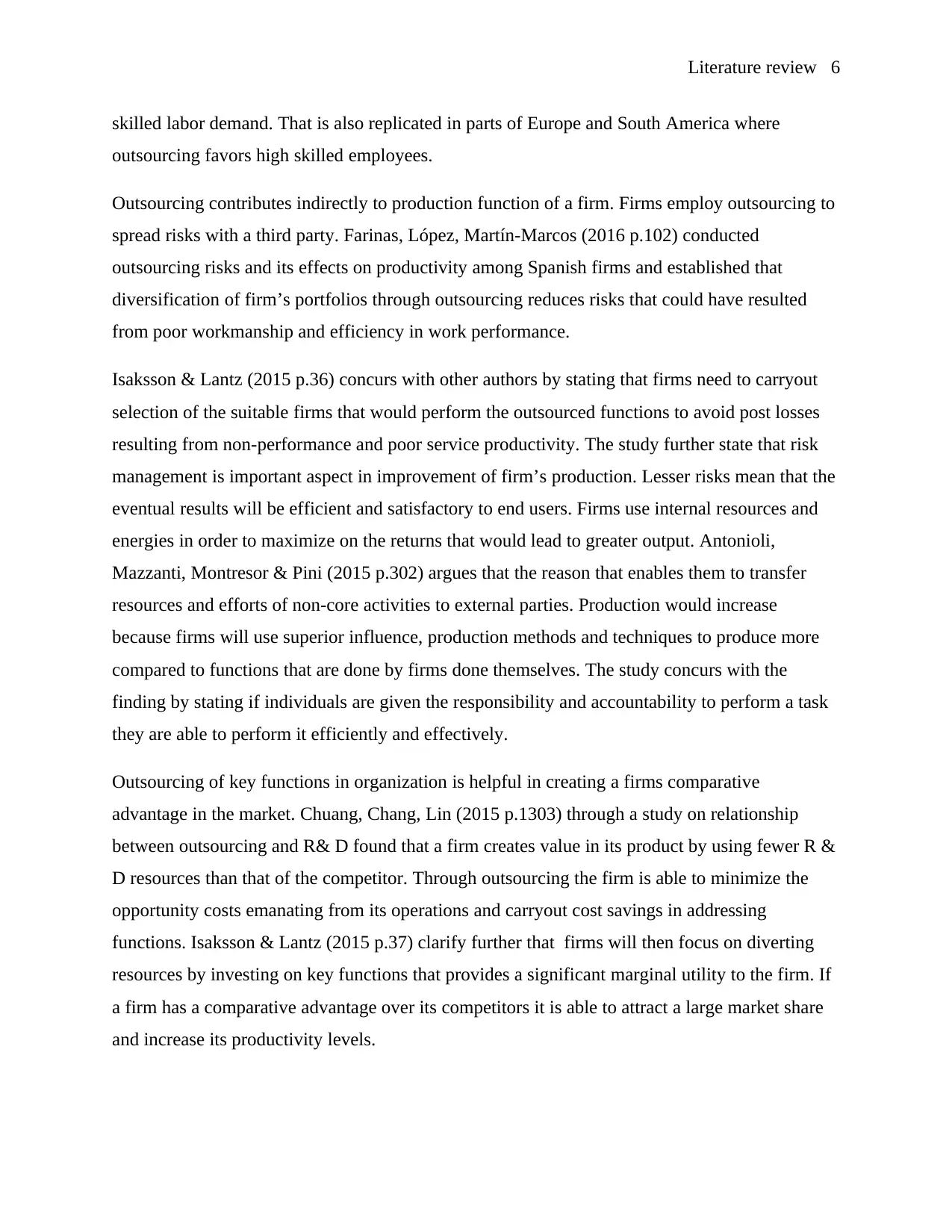
Literature review 6
skilled labor demand. That is also replicated in parts of Europe and South America where
outsourcing favors high skilled employees.
Outsourcing contributes indirectly to production function of a firm. Firms employ outsourcing to
spread risks with a third party. Farinas, López, Martín-Marcos (2016 p.102) conducted
outsourcing risks and its effects on productivity among Spanish firms and established that
diversification of firm’s portfolios through outsourcing reduces risks that could have resulted
from poor workmanship and efficiency in work performance.
Isaksson & Lantz (2015 p.36) concurs with other authors by stating that firms need to carryout
selection of the suitable firms that would perform the outsourced functions to avoid post losses
resulting from non-performance and poor service productivity. The study further state that risk
management is important aspect in improvement of firm’s production. Lesser risks mean that the
eventual results will be efficient and satisfactory to end users. Firms use internal resources and
energies in order to maximize on the returns that would lead to greater output. Antonioli,
Mazzanti, Montresor & Pini (2015 p.302) argues that the reason that enables them to transfer
resources and efforts of non-core activities to external parties. Production would increase
because firms will use superior influence, production methods and techniques to produce more
compared to functions that are done by firms done themselves. The study concurs with the
finding by stating if individuals are given the responsibility and accountability to perform a task
they are able to perform it efficiently and effectively.
Outsourcing of key functions in organization is helpful in creating a firms comparative
advantage in the market. Chuang, Chang, Lin (2015 p.1303) through a study on relationship
between outsourcing and R& D found that a firm creates value in its product by using fewer R &
D resources than that of the competitor. Through outsourcing the firm is able to minimize the
opportunity costs emanating from its operations and carryout cost savings in addressing
functions. Isaksson & Lantz (2015 p.37) clarify further that firms will then focus on diverting
resources by investing on key functions that provides a significant marginal utility to the firm. If
a firm has a comparative advantage over its competitors it is able to attract a large market share
and increase its productivity levels.
skilled labor demand. That is also replicated in parts of Europe and South America where
outsourcing favors high skilled employees.
Outsourcing contributes indirectly to production function of a firm. Firms employ outsourcing to
spread risks with a third party. Farinas, López, Martín-Marcos (2016 p.102) conducted
outsourcing risks and its effects on productivity among Spanish firms and established that
diversification of firm’s portfolios through outsourcing reduces risks that could have resulted
from poor workmanship and efficiency in work performance.
Isaksson & Lantz (2015 p.36) concurs with other authors by stating that firms need to carryout
selection of the suitable firms that would perform the outsourced functions to avoid post losses
resulting from non-performance and poor service productivity. The study further state that risk
management is important aspect in improvement of firm’s production. Lesser risks mean that the
eventual results will be efficient and satisfactory to end users. Firms use internal resources and
energies in order to maximize on the returns that would lead to greater output. Antonioli,
Mazzanti, Montresor & Pini (2015 p.302) argues that the reason that enables them to transfer
resources and efforts of non-core activities to external parties. Production would increase
because firms will use superior influence, production methods and techniques to produce more
compared to functions that are done by firms done themselves. The study concurs with the
finding by stating if individuals are given the responsibility and accountability to perform a task
they are able to perform it efficiently and effectively.
Outsourcing of key functions in organization is helpful in creating a firms comparative
advantage in the market. Chuang, Chang, Lin (2015 p.1303) through a study on relationship
between outsourcing and R& D found that a firm creates value in its product by using fewer R &
D resources than that of the competitor. Through outsourcing the firm is able to minimize the
opportunity costs emanating from its operations and carryout cost savings in addressing
functions. Isaksson & Lantz (2015 p.37) clarify further that firms will then focus on diverting
resources by investing on key functions that provides a significant marginal utility to the firm. If
a firm has a comparative advantage over its competitors it is able to attract a large market share
and increase its productivity levels.
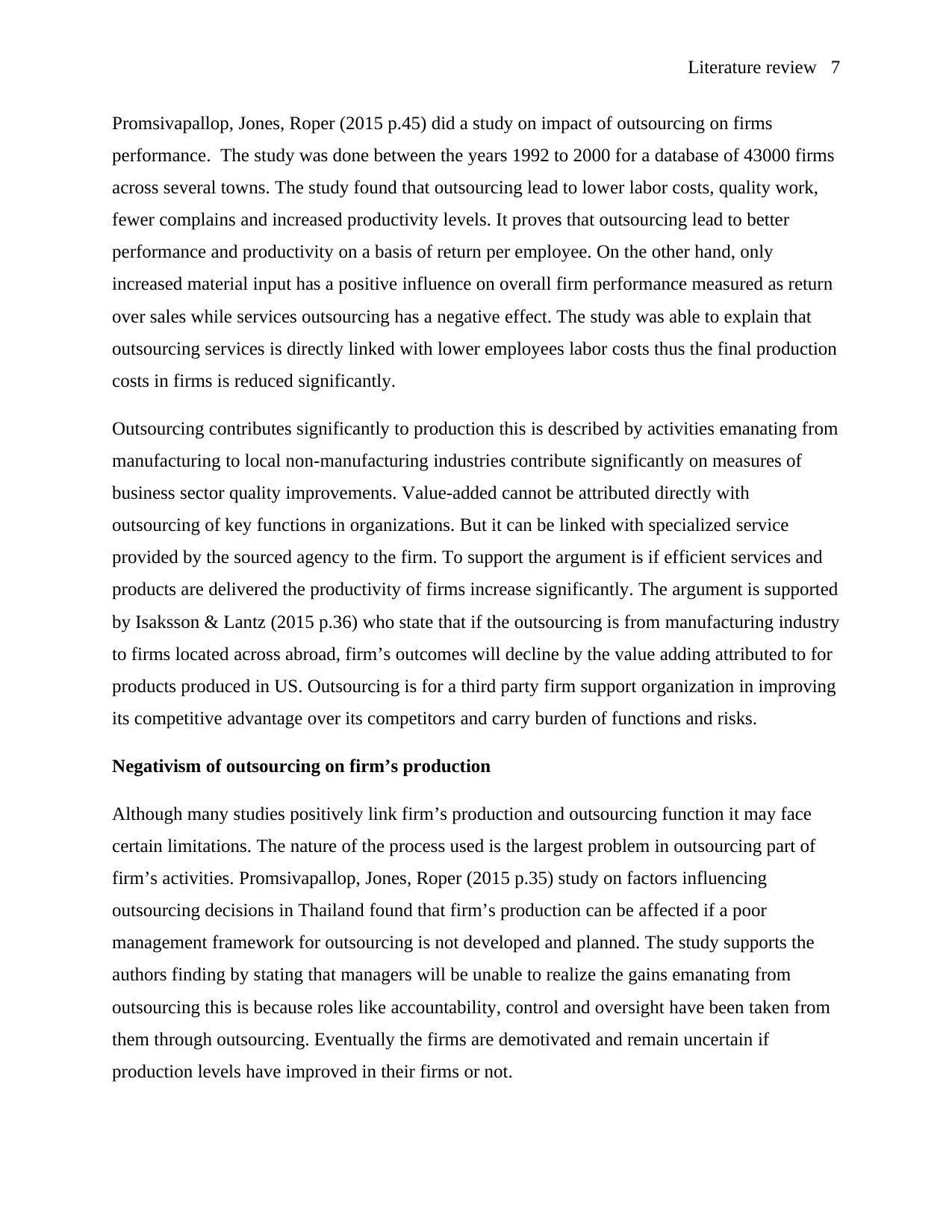
Literature review 7
Promsivapallop, Jones, Roper (2015 p.45) did a study on impact of outsourcing on firms
performance. The study was done between the years 1992 to 2000 for a database of 43000 firms
across several towns. The study found that outsourcing lead to lower labor costs, quality work,
fewer complains and increased productivity levels. It proves that outsourcing lead to better
performance and productivity on a basis of return per employee. On the other hand, only
increased material input has a positive influence on overall firm performance measured as return
over sales while services outsourcing has a negative effect. The study was able to explain that
outsourcing services is directly linked with lower employees labor costs thus the final production
costs in firms is reduced significantly.
Outsourcing contributes significantly to production this is described by activities emanating from
manufacturing to local non-manufacturing industries contribute significantly on measures of
business sector quality improvements. Value-added cannot be attributed directly with
outsourcing of key functions in organizations. But it can be linked with specialized service
provided by the sourced agency to the firm. To support the argument is if efficient services and
products are delivered the productivity of firms increase significantly. The argument is supported
by Isaksson & Lantz (2015 p.36) who state that if the outsourcing is from manufacturing industry
to firms located across abroad, firm’s outcomes will decline by the value adding attributed to for
products produced in US. Outsourcing is for a third party firm support organization in improving
its competitive advantage over its competitors and carry burden of functions and risks.
Negativism of outsourcing on firm’s production
Although many studies positively link firm’s production and outsourcing function it may face
certain limitations. The nature of the process used is the largest problem in outsourcing part of
firm’s activities. Promsivapallop, Jones, Roper (2015 p.35) study on factors influencing
outsourcing decisions in Thailand found that firm’s production can be affected if a poor
management framework for outsourcing is not developed and planned. The study supports the
authors finding by stating that managers will be unable to realize the gains emanating from
outsourcing this is because roles like accountability, control and oversight have been taken from
them through outsourcing. Eventually the firms are demotivated and remain uncertain if
production levels have improved in their firms or not.
Promsivapallop, Jones, Roper (2015 p.45) did a study on impact of outsourcing on firms
performance. The study was done between the years 1992 to 2000 for a database of 43000 firms
across several towns. The study found that outsourcing lead to lower labor costs, quality work,
fewer complains and increased productivity levels. It proves that outsourcing lead to better
performance and productivity on a basis of return per employee. On the other hand, only
increased material input has a positive influence on overall firm performance measured as return
over sales while services outsourcing has a negative effect. The study was able to explain that
outsourcing services is directly linked with lower employees labor costs thus the final production
costs in firms is reduced significantly.
Outsourcing contributes significantly to production this is described by activities emanating from
manufacturing to local non-manufacturing industries contribute significantly on measures of
business sector quality improvements. Value-added cannot be attributed directly with
outsourcing of key functions in organizations. But it can be linked with specialized service
provided by the sourced agency to the firm. To support the argument is if efficient services and
products are delivered the productivity of firms increase significantly. The argument is supported
by Isaksson & Lantz (2015 p.36) who state that if the outsourcing is from manufacturing industry
to firms located across abroad, firm’s outcomes will decline by the value adding attributed to for
products produced in US. Outsourcing is for a third party firm support organization in improving
its competitive advantage over its competitors and carry burden of functions and risks.
Negativism of outsourcing on firm’s production
Although many studies positively link firm’s production and outsourcing function it may face
certain limitations. The nature of the process used is the largest problem in outsourcing part of
firm’s activities. Promsivapallop, Jones, Roper (2015 p.35) study on factors influencing
outsourcing decisions in Thailand found that firm’s production can be affected if a poor
management framework for outsourcing is not developed and planned. The study supports the
authors finding by stating that managers will be unable to realize the gains emanating from
outsourcing this is because roles like accountability, control and oversight have been taken from
them through outsourcing. Eventually the firms are demotivated and remain uncertain if
production levels have improved in their firms or not.
Paraphrase This Document
Need a fresh take? Get an instant paraphrase of this document with our AI Paraphraser
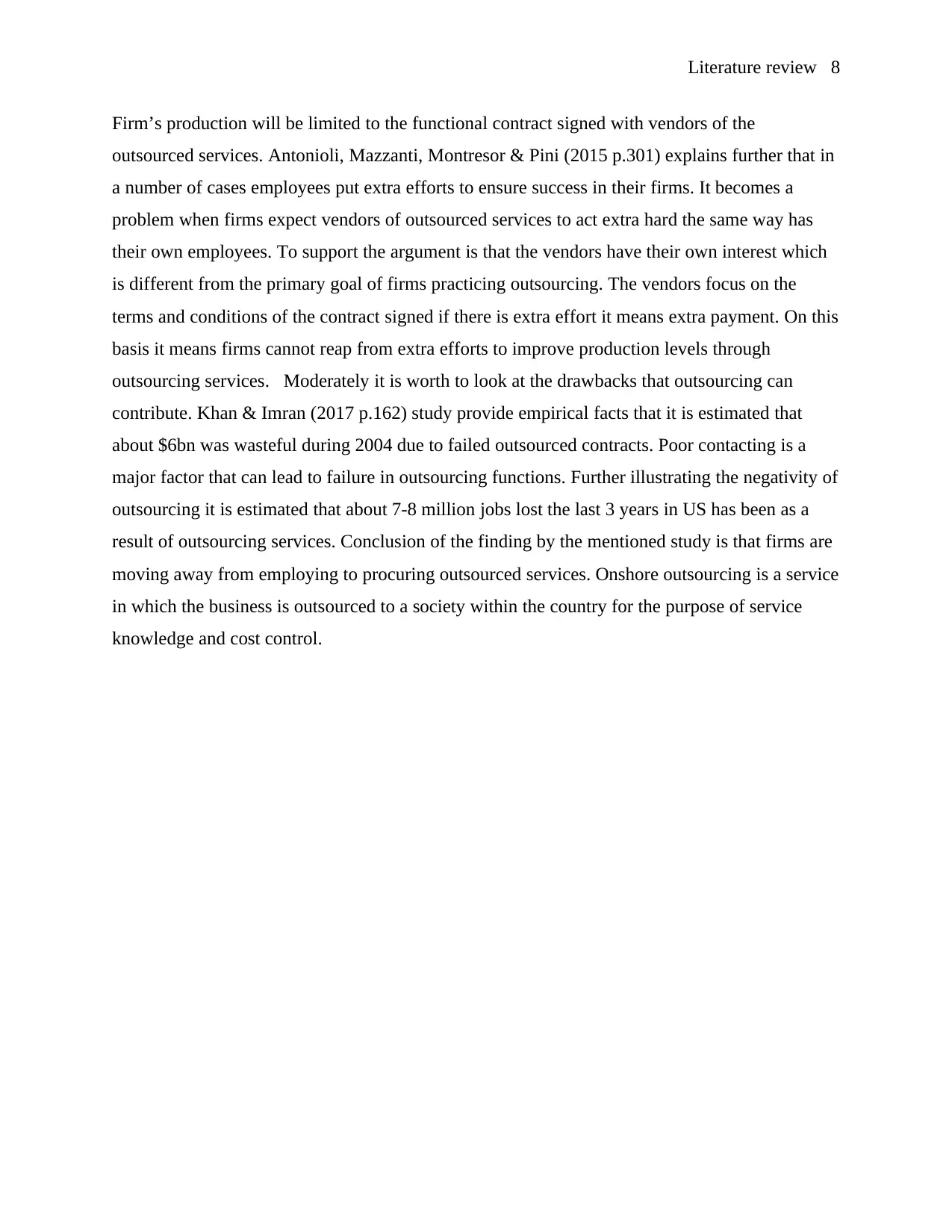
Literature review 8
Firm’s production will be limited to the functional contract signed with vendors of the
outsourced services. Antonioli, Mazzanti, Montresor & Pini (2015 p.301) explains further that in
a number of cases employees put extra efforts to ensure success in their firms. It becomes a
problem when firms expect vendors of outsourced services to act extra hard the same way has
their own employees. To support the argument is that the vendors have their own interest which
is different from the primary goal of firms practicing outsourcing. The vendors focus on the
terms and conditions of the contract signed if there is extra effort it means extra payment. On this
basis it means firms cannot reap from extra efforts to improve production levels through
outsourcing services. Moderately it is worth to look at the drawbacks that outsourcing can
contribute. Khan & Imran (2017 p.162) study provide empirical facts that it is estimated that
about $6bn was wasteful during 2004 due to failed outsourced contracts. Poor contacting is a
major factor that can lead to failure in outsourcing functions. Further illustrating the negativity of
outsourcing it is estimated that about 7-8 million jobs lost the last 3 years in US has been as a
result of outsourcing services. Conclusion of the finding by the mentioned study is that firms are
moving away from employing to procuring outsourced services. Onshore outsourcing is a service
in which the business is outsourced to a society within the country for the purpose of service
knowledge and cost control.
Firm’s production will be limited to the functional contract signed with vendors of the
outsourced services. Antonioli, Mazzanti, Montresor & Pini (2015 p.301) explains further that in
a number of cases employees put extra efforts to ensure success in their firms. It becomes a
problem when firms expect vendors of outsourced services to act extra hard the same way has
their own employees. To support the argument is that the vendors have their own interest which
is different from the primary goal of firms practicing outsourcing. The vendors focus on the
terms and conditions of the contract signed if there is extra effort it means extra payment. On this
basis it means firms cannot reap from extra efforts to improve production levels through
outsourcing services. Moderately it is worth to look at the drawbacks that outsourcing can
contribute. Khan & Imran (2017 p.162) study provide empirical facts that it is estimated that
about $6bn was wasteful during 2004 due to failed outsourced contracts. Poor contacting is a
major factor that can lead to failure in outsourcing functions. Further illustrating the negativity of
outsourcing it is estimated that about 7-8 million jobs lost the last 3 years in US has been as a
result of outsourcing services. Conclusion of the finding by the mentioned study is that firms are
moving away from employing to procuring outsourced services. Onshore outsourcing is a service
in which the business is outsourced to a society within the country for the purpose of service
knowledge and cost control.
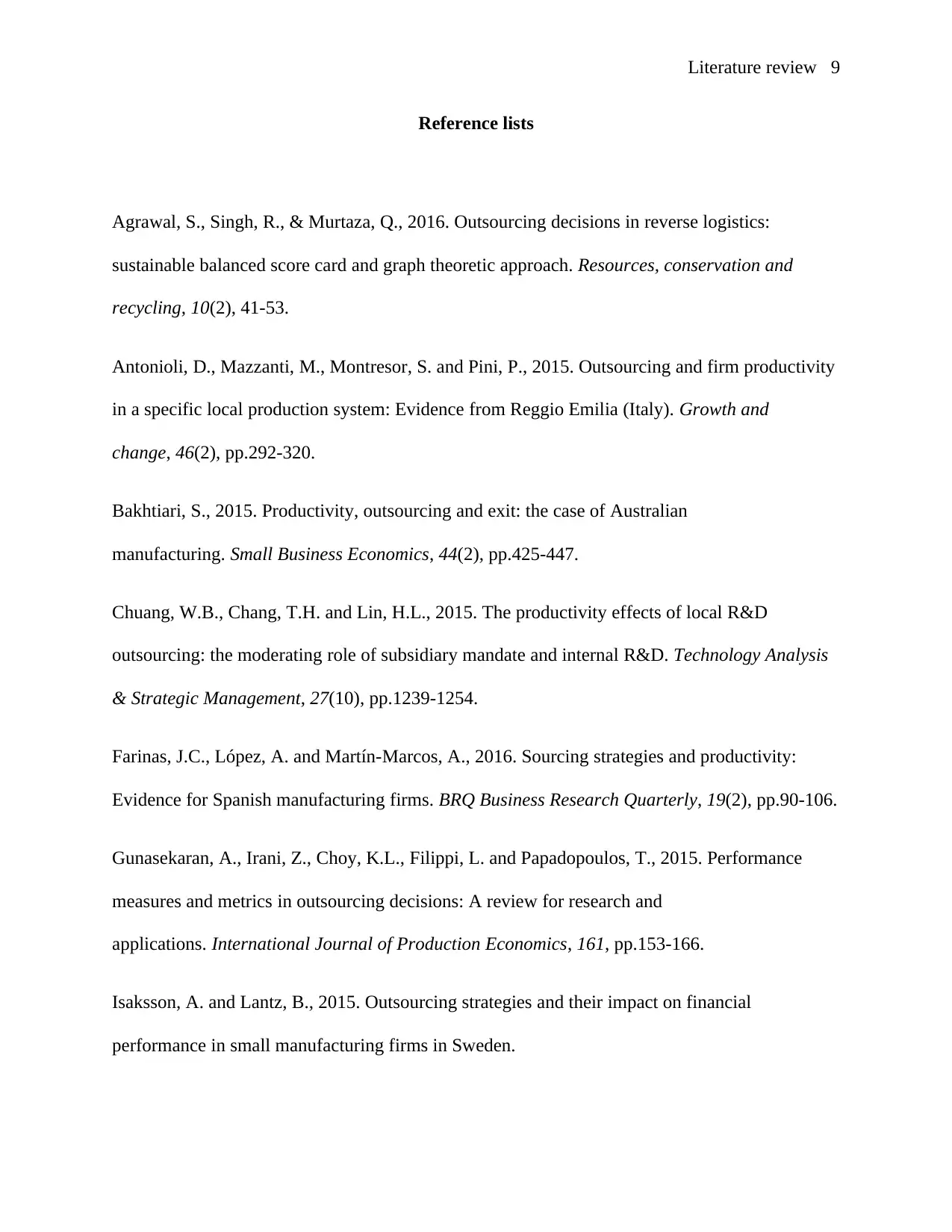
Literature review 9
Reference lists
Agrawal, S., Singh, R., & Murtaza, Q., 2016. Outsourcing decisions in reverse logistics:
sustainable balanced score card and graph theoretic approach. Resources, conservation and
recycling, 10(2), 41-53.
Antonioli, D., Mazzanti, M., Montresor, S. and Pini, P., 2015. Outsourcing and firm productivity
in a specific local production system: Evidence from Reggio Emilia (Italy). Growth and
change, 46(2), pp.292-320.
Bakhtiari, S., 2015. Productivity, outsourcing and exit: the case of Australian
manufacturing. Small Business Economics, 44(2), pp.425-447.
Chuang, W.B., Chang, T.H. and Lin, H.L., 2015. The productivity effects of local R&D
outsourcing: the moderating role of subsidiary mandate and internal R&D. Technology Analysis
& Strategic Management, 27(10), pp.1239-1254.
Farinas, J.C., López, A. and Martín-Marcos, A., 2016. Sourcing strategies and productivity:
Evidence for Spanish manufacturing firms. BRQ Business Research Quarterly, 19(2), pp.90-106.
Gunasekaran, A., Irani, Z., Choy, K.L., Filippi, L. and Papadopoulos, T., 2015. Performance
measures and metrics in outsourcing decisions: A review for research and
applications. International Journal of Production Economics, 161, pp.153-166.
Isaksson, A. and Lantz, B., 2015. Outsourcing strategies and their impact on financial
performance in small manufacturing firms in Sweden.
Reference lists
Agrawal, S., Singh, R., & Murtaza, Q., 2016. Outsourcing decisions in reverse logistics:
sustainable balanced score card and graph theoretic approach. Resources, conservation and
recycling, 10(2), 41-53.
Antonioli, D., Mazzanti, M., Montresor, S. and Pini, P., 2015. Outsourcing and firm productivity
in a specific local production system: Evidence from Reggio Emilia (Italy). Growth and
change, 46(2), pp.292-320.
Bakhtiari, S., 2015. Productivity, outsourcing and exit: the case of Australian
manufacturing. Small Business Economics, 44(2), pp.425-447.
Chuang, W.B., Chang, T.H. and Lin, H.L., 2015. The productivity effects of local R&D
outsourcing: the moderating role of subsidiary mandate and internal R&D. Technology Analysis
& Strategic Management, 27(10), pp.1239-1254.
Farinas, J.C., López, A. and Martín-Marcos, A., 2016. Sourcing strategies and productivity:
Evidence for Spanish manufacturing firms. BRQ Business Research Quarterly, 19(2), pp.90-106.
Gunasekaran, A., Irani, Z., Choy, K.L., Filippi, L. and Papadopoulos, T., 2015. Performance
measures and metrics in outsourcing decisions: A review for research and
applications. International Journal of Production Economics, 161, pp.153-166.
Isaksson, A. and Lantz, B., 2015. Outsourcing strategies and their impact on financial
performance in small manufacturing firms in Sweden.
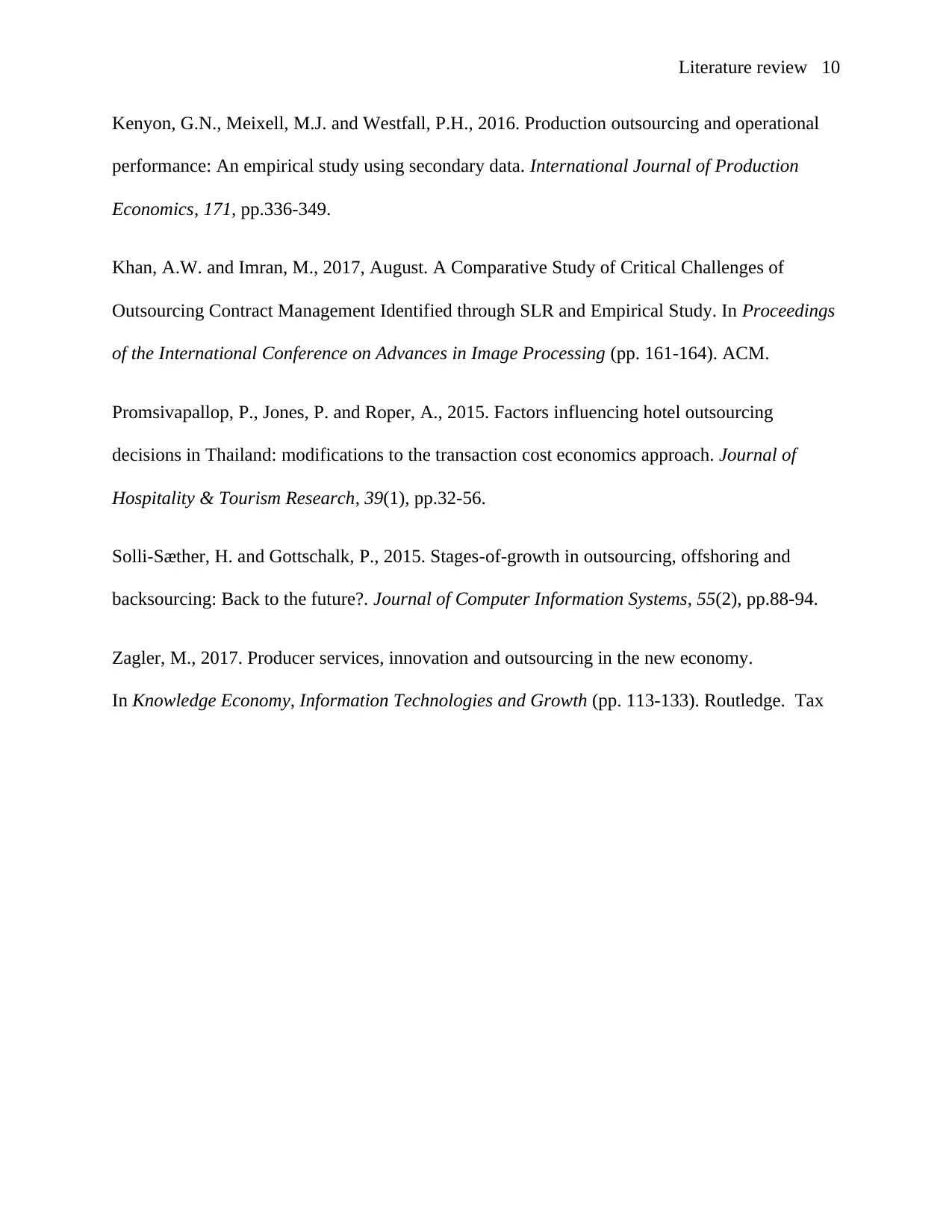
Literature review 10
Kenyon, G.N., Meixell, M.J. and Westfall, P.H., 2016. Production outsourcing and operational
performance: An empirical study using secondary data. International Journal of Production
Economics, 171, pp.336-349.
Khan, A.W. and Imran, M., 2017, August. A Comparative Study of Critical Challenges of
Outsourcing Contract Management Identified through SLR and Empirical Study. In Proceedings
of the International Conference on Advances in Image Processing (pp. 161-164). ACM.
Promsivapallop, P., Jones, P. and Roper, A., 2015. Factors influencing hotel outsourcing
decisions in Thailand: modifications to the transaction cost economics approach. Journal of
Hospitality & Tourism Research, 39(1), pp.32-56.
Solli-Sæther, H. and Gottschalk, P., 2015. Stages-of-growth in outsourcing, offshoring and
backsourcing: Back to the future?. Journal of Computer Information Systems, 55(2), pp.88-94.
Zagler, M., 2017. Producer services, innovation and outsourcing in the new economy.
In Knowledge Economy, Information Technologies and Growth (pp. 113-133). Routledge. Tax
Kenyon, G.N., Meixell, M.J. and Westfall, P.H., 2016. Production outsourcing and operational
performance: An empirical study using secondary data. International Journal of Production
Economics, 171, pp.336-349.
Khan, A.W. and Imran, M., 2017, August. A Comparative Study of Critical Challenges of
Outsourcing Contract Management Identified through SLR and Empirical Study. In Proceedings
of the International Conference on Advances in Image Processing (pp. 161-164). ACM.
Promsivapallop, P., Jones, P. and Roper, A., 2015. Factors influencing hotel outsourcing
decisions in Thailand: modifications to the transaction cost economics approach. Journal of
Hospitality & Tourism Research, 39(1), pp.32-56.
Solli-Sæther, H. and Gottschalk, P., 2015. Stages-of-growth in outsourcing, offshoring and
backsourcing: Back to the future?. Journal of Computer Information Systems, 55(2), pp.88-94.
Zagler, M., 2017. Producer services, innovation and outsourcing in the new economy.
In Knowledge Economy, Information Technologies and Growth (pp. 113-133). Routledge. Tax
1 out of 10
Your All-in-One AI-Powered Toolkit for Academic Success.
+13062052269
info@desklib.com
Available 24*7 on WhatsApp / Email
![[object Object]](/_next/static/media/star-bottom.7253800d.svg)
Unlock your academic potential
© 2024 | Zucol Services PVT LTD | All rights reserved.

